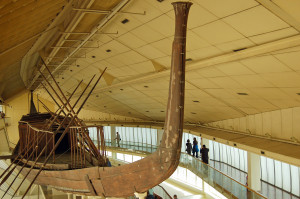In 1954, archaeologists discovered 1,224 neatly arranged pieces of cedar wood in a pit carved in the bedrock just south of the Great Pyramid of Khufu (also called Cheops), the pharaoh who ruled Egypt from about 2589 to 2566 B.C. After studying ancient shipbuilding techniques, workers eventually reassembled the pieces into a boat 142 feet long and 20 feet wide. The cedar planks are held together with vegetable rope, which was also buried in the pit. When placed in water, the wood swells and the rope shrinks, making the hull water-tight without the need for additional sealing. With no place for a sail, the flat-bottomed boat came equipped with six pairs of oars, the pair at the rear used for steering.
The shape of the boat, with an elongated prow and stern suggesting lotus stalks, resembles so-called “solar boats” shown on ancient Egyptian drawings transporting the sun god on his daily journey across the sky. Since deceased pharaohs were believed to accompany the sun god on his travels, some Egyptologists have speculated that the boat was buried, like the pharaoh’s other earthly possessions, for the pharaoh to use in the afterlife. But a disassembled boat seems an odd choice for a deified pharaoh to use while traversing the heavens and the boat shows evidence of having been in earthly water before being disassembled and placed in its pit. So the boat may have been used to transport the body of Khufu down the Nile from his capital in Memphis to his tomb in the Great Pyramid before it was disassembled and buried to prevent its reuse by mere mortals. Or perhaps the boat was used by Khufu for trips along the Nile to greet his subjects.
Whatever its original purpose, the world’s oldest intact boat is as seaworthy as the day it was built. Khufu’s reassembled boat is now displayed near his pyramid in a building also displaying pictures of its discovery and reconstruction.
